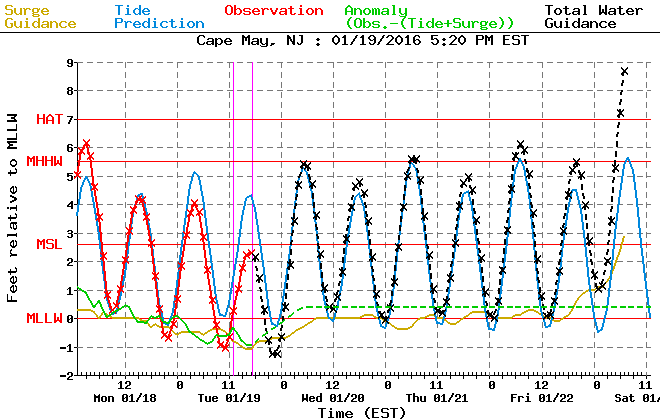As a forecaster and communicator, I try and approach my audience a lot like I would my mother. Would my mom understand what I’m talking about? Sometimes I deviate and get nerdy; we all do. But when it comes to the forecast details, it has to be simple, clear, and easy to understand.
So my mother sent me an interesting text message today. She said:
Ok. I’m getting anxious. Or curious. I’ve heard so many maybe this or maybe that’s. I want the truth. I’m sick of speculation.
That’s such a great mom text.
In the run up to this major East Coast winter storm, blizzard, Winter Storm Jonas, whatever you use to describe it, you’re going to get a ton of this speculation.
So today, you’re all my mother, and consider this my survival guide for you.
What’s going on here?
The weather models have been hooked on this idea of a major winter storm in the Eastern US for awhile now. There is good agreement among all the various models we use that something is going to happen. Someone’s getting a major storm.
So how much snow am I getting?
No one can answer that question today unfortunately. What we know is that a number of factors are going to contribute to this storm being loaded with moisture. In other words, someone is going to get a *lot* of snow. It’s just not possible to say who that is yet.
Right, right, I get that, but give me your best shot.
This storm is big, slow, and it has a number of complex parts to it that will make it difficult to peg down until we are closer in than usual. But, some trends have evolved in the last couple days that lead us to believe a few facts about this storm.
First, it will be a *big* storm. That means even if you don’t get snow, you may get impacts. It will be slow moving. It will have wind…lots of wind. It will have major, major coastal impacts. Depending on track, we could be looking at a top 5-10 coastal flooding event for folks from the Jersey Shore into Virginia perhaps. That is a serious issue.
But what about snow? The storm has slowly trended south on the weather models. Additionally, it has a very, very sharp gradient on the north side. In plain English? If you live on the northern fringe of this storm, there’s going to be a razor thin margin between major snow and conversational snow.
Here now, a map of where I think things stand as of Tuesday afternoon. Remember, this is subject to change.

The trouble is in New England, New York City, and Northern NJ. The models show a tremendous cutoff in snowfall here. The next map is a weather model’s output for precipitation (liquid, not snow). I’ve focused on the NYC area.

Why am I showing this? Notice how in the Central Jersey area, the model spits out about 1.5″ liquid. Go 50 miles north from there. So, like Orange County, NY? About 0.5″ liquid. A 1″ liquid is roughly equivalent to about 10″ of snow. So 10″ snow difference over 50 miles, and the reality is likely that it will be even sharper than this. You’re talking about (surprise!) a major difference in snow totals likely over a short distance over a major population center.
Bottom line in all this: I have higher confidence in heavy snow hitting Virginia and probably DC right now than I do for the Northern half of NJ, New York, or New England. I don’t focus on North Carolina much since the majority of my family and friends are between DC and Boston. But this has potential to be a big storm in a good chunk of NC also.
Alright, so when does all this unfold?
Snow should start in Virginia as early as later Friday morning, and it probably won’t end until about Saturday night. In Philly, it’s a Friday afternoon start and late Saturday night finish. Add a couple hours to all this as you go north to NYC. I have lower confidence in anything further north, so I won’t speculate beyond this.
What about this coastal flooding?
Yeah, this one goes unchecked sometimes. Snow is way sexier, but this is way more damaging potentially. The NWS office in Mount Holly has done an excellent job highlighting this risk. If you look at storm surge guidance for Cape May, NJ, you’ll see the first high tide cycle impacted late Friday ends up at a water level of about 8.5-8.7 feet. Sandy saw a tide level of 8.9 feet there, October 29, 2011 was 8.7 feet, the December 1992 nor’easter was 8.6 feet. An 8.5 foot tide level would rank in the top 8 all time at Cape May. This one’s big. It’s like a 90’s throwback nor’easter.

If you live along the coast or Back Bays of New Jersey, Delmarva, Virginia, you should begin planning for the possibility of 2-3 high tide cycles like this. If the storm track shifts a bit or the intensity changes, we could see these values change. It’s a fluid forecast, but it’s a serious issue along the coast. Follow your local NWS office for info and guidance.
So will it be a blizzard?
Maybe for someone. It’s entirely possible, but specific criteria must be met regarding wind speed and visibility. It’s too soon to say exactly where and who or how long, but it’s a distinct possibility.
That’s all for now. Feel free to ask any questions and follow me on Twitter at @mattlanza.













